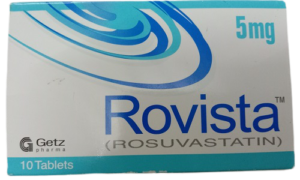Rovista
Rovista (Rosuvastatin) tablets are a synthetic lipid-lowering agent (statins) for oral administration. It is used to lower cholesterol and fats in the blood.
How it works (Mechanism of Action):
- Rosuvastatin blocks an enzyme in the liver called HMG-CoA reductase.
- This enzyme helps make cholesterol, so by blocking it:
- The liver makes less cholesterol.
- The liver then pulls more LDL (“bad cholesterol”) out of the blood.
- It also reduces the production of VLDL, another type of bad fat.
- Overall, this leads to lower levels of bad cholesterol (LDL and VLDL) and can help prevent heart disease.
Package Contains: Each packet of Rovista contains 10 tablets of 5mg & a leaflet. It is also available as Rovista 30 tablets box of 10mg & 20mg. 
Composition: Each film-coated tablet contains:
Rosuvastatin Calcium USP, equivalent to Rosuvastatin 5mg.
Dosage: As directed by the physician or see package insert for full prescribing Information.
Therapeutic Indications / Uses: Rovista (Rosuvastatin) is indicated for the treatment of
Hyperlipidemia and Mixed Dyslipidemia: As adjunctive therapy to diet to reduce elevated Total-C, LDL-C, ApoB, non-HDL-C, and triglycerides and to increase HDL-C in adult patients with primary hyperlipidemia or mixed dyslipidemia. Lipid-altering agents should be used in addition to a diet restricted in saturated fat and cholesterol when the response to diet and nonpharmacological interventions alone has been inadequate.
Pediatric Patients with Familial Hypercholesterolemia: As an adjunct to diet to reduce Total-C, LDL-C and ApoB levels in children and adolescents 8 to 17 years of age with heterozygous familial hypercholesterolemia if after an adequate trial of diet therapy the following findings are present: LDL-C >190 mg/dL, or >160 mg/dL along with a positive family history of premature cardiovascular disease (CVD) or two or more other CVD risk factors.
As an adjunct to diet to reduce LDL-C, Total-C, non-HDL-C, and ApoB in children and adolescents 7 to 17 years of age with homozygous familial hypercholesterolemia, either alone or with other lipid-lowering treatments (e.g, LDL apheresis).
Hypertriglyceridemia: As adjunctive therapy to diet for the treatment of adult patients with hypertriglyceridemia.
Primary Dysbetalipoproteinemia (Type III Hyperlipoproteinemia): As an adjunct to diet for the treatment of adult patients with primary dysbetalipoproteinemia (Type III Hyperlipoproteinemia).
Homozygous Familial Hypercholesterolemia: As adjunctive therapy to other lipid-lowering treatments (e.g, LDL apheresis) or alone if such treatments are unavailable to reduce LDL-C, Total-G. And ApoB in adult patients with homozygous familial hypercholesterolemia.
Slowing of the Progression of Atherosclerosis: As adjunctive therapy to diet to slow the progression of atherosclerosis in adult patients as part of a treatment strategy to lower Total-C and LDL-C to target levels.
Primary Prevention of Cardiovascular Disease: In individuals without clinically evident coronary heart disease but with an increased risk of cardiovascular disease based on age 50 years old in men and 60 years old in women, hsCRP 2 mg/L, and the presence of at least one additional cardiovascular disease risk factor such as hypertension, low HDL-C, smoking, or a family history of premature coronary heart disease, Rovista (Rosuvastatin) is indicated to:
- reduce the risk of stroke,
- reduce the risk of myocardial infarction,
- reduce the risk of arterial revascularization procedures.
Dosage & Administration: General: The dose range for Rovista is 5mg to 40mg orally once daily. It can be administered as a single dose at any time of day, with or without food.
The usual starting dose is 10-20mg. The usual starting dose in adult patients with homozygous familial hypercholesterolemia is 20mg once daily.
When initiating Rovista therapy or switching from another HMG-CoA reductase inhibitor therapy, the appropriate starting dose should first be utilized, and only then titrated according to the patient’s response and individualized goal of therapy.
After initiation or upon titration of Rovista, lipid levels should be analysed within 2 to 4 weeks and the dosage adjusted accordingly.
The maximum 40mg dose of Rovista (Rosuvastatin) should be used only for those patients who have not achieved their LDL-C goal utilizing the 20mg dose.
Contraindications: Rosuvastatin is contraindicated:
- In patients with hypersensitivity to rosuvastatin or to any of the excipients of the product.
- In patients with active liver disease, including unexplained, persistent elevations of serum transaminases and any serum transaminase elevation exceeding 3x the upper limit of normal (ULN).
- During pregnancy and lactation and in women of childbearing potential not using appropriate contraceptive measures.
- In patients with severe renal insufficiency (Creatinine clearance <30mL/min.)
- In patients with myopathy.
- In patients receiving concomitant cyclosporine.
- Concomitant use of protease inhibitors in HIV patients.
The 40mg dose is contraindicated in patients with predisposing factors for myopathy/rhabdomyolysis. Such factors include:
- Moderate renal insufficiency (Creatinine clearance, <60mL/min).
- Hypothyroidism.
- Personal or family history of hereditary muscular disorders.
- Previous history of muscular toxicity with another HMG-CoA reductase inhibitor or fibrate.
- Alcohol abuse.
- Situations where an increase in plasma levels may occur.
- Concomitant use of fibrates.
- Asian patient.
Adverse Reactions / Side Effects: Rosuvastatin is generally well-tolerated. Adverse reactions have usually been mild and transient.
Common: Headache, dizziness, constipation, nausea, abdominal pain, myalgia, asthenia, and diabetic mellitus. Uncommon: Pruritus, rash, and urticaria.
Rare: Hypersensitivity reactions including angioedema, myopathy, rhabdomyolysis, thrombocytopenia, increased hepatic transaminases, lupus-like syndrome, muscle rupture, and pancreatitis.
Drug Interactions:
Cyclosporine increased rosuvastatin exposure and may result in increased risk of myopathy.
Gemfibrozil significantly increased rosuvastatin exposure. Due to an observed increased risk of myopathy/rhabdomyolysis, combination therapy with rosuvastatin and gemfibrozil should be avoided.
Coadministration of rosuvastatin with certain anti-viral drugs has differing effects on rosuvastatin exposure and may increase the risk of myopathy. Darolutamide increased rosuvastatin exposure more than 5 fold and increase the risk of myopathy.
Regorafenib increased rosuvastatin exposure and may increase the risk of myopathy.
Rosuvastatin significantly increased INR in patients receiving coumarin anticoagulants. Therefore, caution should be exercised when coumarin anticoagulants are given in conjunction with rosuvastatin.
Cases of myopathy, including rhabdomyolysis, have been reported with HMG-CoA reductase inhibitors, including rosuvastatin, coadministered with colchicine, and caution should be exercised when prescribing Rosuvastatin with colchicine.
The simultaneous dosing of rosuvastatin with an antacid suspension containing aluminium and magnesium hydroxide resulted in a decrease in rosuvastatin plasma concentration of approximately 50%. The antacid should be taken at least 2 hours after rosuvastatin administration.
The risk of skeletal muscle effects may be enhanced when rosuvastatin is used in combination with niacin; a reduction in rosuvastatin dosage should be considered.
Storage / Instructions: Do not store above 30°C. Protect from sunlight and moisture. Please read the contents carefully before use. This package insert is continually updated from time to time. 
Manufactured & Buy Online:
Rovista tablets are manufactured by Getz Pharma PVT LIMITED.
This is the link to the manufacturer: https://getzpharma
You can buy this medicine online at: https://dawailo.pk
Or it can be purchased from any nearby pharmacy.